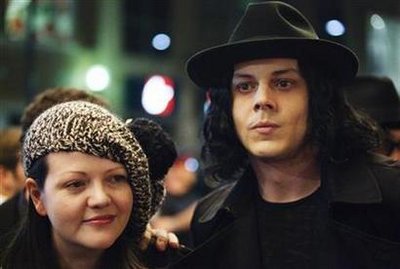

 |
|
Jack and Meg White arrive for the "White Stripes: Under the Great White Northern Lights" film screening during the 34th Toronto International Film Festival, September 18, 2009. The festival runs from September 10-19.[Agencies] |
AUSTIN, Texas – As stylish as the band it depicts and occasionally as enigmatic, "The White Stripes: Under Great White Northern Lights" stands out among tour films largely because of the strange tour at hand.
Released this week on DVD and other formats, the documentary will please fans, and holds interest even for those new to the band.
Catching the duo during an eccentric tour of Canada -- they insist on playing every province, and on hitting towns even Canadian bands rarely visit -- filmmaker Emmett Malloy isn't always in on the conspiracy but does witness gigs that sometimes look like elaborate pranks: The "one-note show," for example, in which Jack and Meg White take the stage, deliver one brash beat's worth of sound, and leave.
More often, though, the unusual concerts feel like sincere (and successful) attempts to freshen the performer/audience dynamic. The band plays for passengers on a public bus, for kids at a YMCA camp, and for a gathering of Inuit elders, with whom they swap tunes and tales.
The result is a portrait of Jack White as a artist who would (occasionally, at least) happily trade a sold-out stadium show for the chance to see the places he visits from an odd perspective. His softspoken bandmate -- when she does speak, Meg White is so quiet the filmmakers repeat her words in subtitles -- comes across as a tolerant participant in these outings rather than a full co-plotter.
After the acoustic blues and traditional music they play for small gatherings, the raw bluster of their fully staged concerts is doubly bracing. We see the band blow through their own back catalog and cover songs by artists from Blind Willie McTell to Dolly Parton, with the singer often seeming at odds with microphones that can't quite withstand his assault.
Malloy and cinematographer Giles Dunning adhere to the band's famous color scheme, mixing beautiful black-and-white photography with occasional bursts of red. They rarely invent settings beyond those presented by the performances themselves, but when they do -- as with an interview set in a rustic room, where a man lies, unacknowledged, on a bed behind the band -- they perfectly capture this band's sometimes earnest, sometimes self-mythologizing spirit.